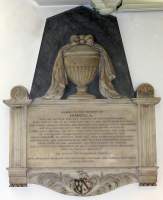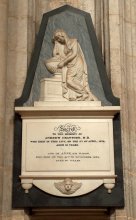George Lupton (b.1792-active 1827)
Typical work by Lupton, St John's Wood Church.
The statuary George Lupton produced a number of modest but accomplished small tablet monuments, mostly in the white-on-black panel form, during the 1820s.
I first came across the statuary George Lupton's work in Winchester Cathedral, in the monument to Andrew Crawford, d.1824. This has an attached figure of a girl leaning on a funereal urn, on a small pedestal. It is conventional in subject, and to some extent in pose - she stands cross legged, and rests her head on her hand, the elbow resting on the pot. But a closer look shows a degree of invention - the direction of her legs and angle of the hip are pleasingly awkward, and you realise she is putting rather more of her weight than usual against the pot. The twist to the body is well executed, and the drapery a cut above the average. The monument bears a little winged cherubic head, classical rather than the usual baroque, on the apron underneath the inscribed plaque. There do not seem to be other examples of his work in Winchester, but in London are a small group of his works, not with figure sculpture: one in Marylebone Parish Church on Marylebone Road, and the others in St Johnís Wood Chapel. On the Surrey border, in Beddington, is another, rather simple piece by Lupton.
The Marylebone example, to Lettice, daughter of Thomas Patten, d. 1817, is the earliest, and is in the form of a decorated Classical panel, with a dove bearing a sprig of leaves in the pediment, leafy fronds below, and upturned torches on the side pillars. In St Johnís Wood Chapel are two signed pieces by Lupton, to Isabella Bartlet (our picture above) and Charles Binny, and a third, unsigned, to Susannah Maria Flint which is such a close copy of the Bartlet monument that it is reasonable to presume a common authorship. All three are marble panels with a summit pot covered in a knotted drape hanging almost symmetrically over it. The style of the fluted side pillars is identical, and the main difference is in the treatment of the apron, which bears fronds and a shield in the two signed cases, and a wreath and ribbons in the third. All date from the 1820s.
Andrew Crawford, d.1824.
From Gunnis we learn that Lupton was born in 1792, and Nollekins referred to him as one of his workers in his will, leaving him £100 (about £10k in 2020s money). He has a few other signed tablets in southern England; these however extend his range only as far forward as 1827, or two years after the Flint monument. Other than these few dates, and that he worked from the New Road, London, like so many statuaries of this time, he is obscure.
Introduction to church monuments // Sculpture pages
Visitors to this page since 7 September 2012: 5,633

